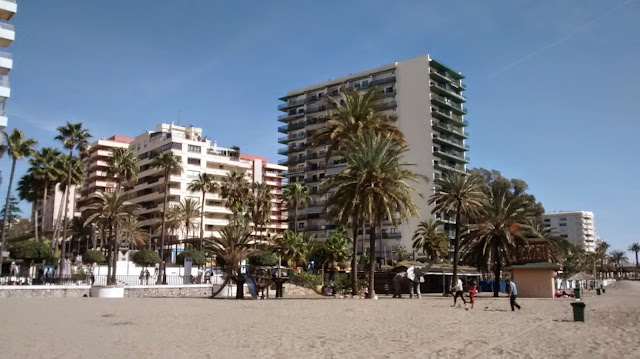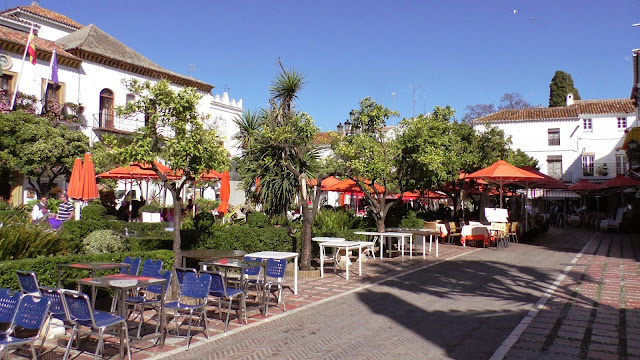Answer: nothing whatsoever, apart from yesterday, Wednesday, 25th February 2015, in Malaga, for two particular English visitors...
1. Pablo Picasso.
Picasso was born in Malaga in 1881, but only lived there until the age of 10, when his father, an art teacher, moved the family to La Coruna, where he had obtained a new position. Nevertheless, Malaga claims Picasso as its son, and the city boasts two museums dedicated solely to his work, a small place at his birthplace, and a more substantial collection on permanent loan from the Picasso family. It was this one we visited, located in an ancient palace in the old quarter beside the cathedral.
For some reason our visits to art galleries never go well. Gill finds them prissy, the arty customers ridiculous, and she would much rather explore a real landscape than stare at a painted one. My issue is somewhat different, I am very comfortable in art galleries, my degree is in History of Art, and I have spent forty odd years chasing down the rag-tag fragments of art history in the various places we have visit. Often it is said that we are in some kind of inexorable process of cultural decline where all people ever do is post their selfies on Instagram and tweet facile drivel. However, having visited art galleries over the decades sometimes the opposite seems true, for now they seems busier than ever, frequented by a wide range of people. This is great, a sure sign of the democratisation of what was once considered high culture. It does presents challenges though. Sometimes the galleries are so full of people that it becomes difficult to get to see the pictures. The sense you get of peaceful contemplation when places were half empty evaporates and you end up having to compete to see the paintings. This is exacerbated in the Picasso museum by the place itself. The building it is in is a beautifully remodelled Renaissance mansion, mujedar influenced, with a lovely central courtyard.

It is a very pretty house. The rooms, however, are quite small, with only a handful of works in each. This should give a certain intimacy to the experience, but if the place is busy, which it was, then the crowds get in the way of the pictures, which is a shame. Get there early, or go just before it closes would be my advice.

A couple of other things conspired to ruin the experience. School groups are an irritation, but they were well behaved, and the pupils so keen to get out of the place that they scooted through like Billy-whizz on speed. Not so the dozen or so American tourists with an expert guide in tow. She parked herself in front of the most beautiful and interesting works and proceeded to hold forth using full-on art expert gobbledygook; a 10 minute mini-lecture in front of each picture - loud, opinionated and inconsiderate.Despite this, I don't regret going. The collection itself features work from the artist's youth, through to his final works from the early 1970s when was aged over 90. These I enjoyed most. Like the late Rembrandt, it was as if the artist went beyond technique, and the vibrancy of his brushwork became a cipher for the creative process itself - vivid and vital - the shimmering shadow of the aged painter's gesture.
 |
Picasso - 1972, the painter as magician!
2. Cured tuna fish
We escaped the museum and went in search of lunch. The medieval heart of Malaga is packed full of bars and cafes offering tapas, most with a friendly senorita outside keen to impress upon the browsing tourist the delights of their particular establishment. The result -, browsing is difficult, and combined with a chilly breeze blowing down tsome streets, finding that particular combination of sunny spot, yummy food and agreeable ambiance to some time. By the time we did it felt that we had wandered through every palm shaded square and shadowy alley in the old quarter of the city.
|
3. The theme from the Godfather
The cafe we found was sheltered from the wind and a bit of a suntrap. We ordered three tapas - tuna in olive oul with tomatoes, smoked tuna with cheese and patatas bravas. Gill had a red house wine, I had white. It was all very good. We had only just tucked-in when the first, inevitable street musician struck up. A saxophonist who must have felt a plaintive rendition of the theme tune from the Godfather would add romance to the scene. Instead, it just made the place feel somewhat sinister. I do wonder if it was this that prompted a passing French tourist to advise Gill to hide her day-sack from view, that the soundtrack made people feel nervous, rather than any real imminent threat of street-crime.





After a while the Godfather wandered off to spook other diners elsewhere. He was replaced by a guitarist whose version of Concerto d'Aranthuez made up in its drama and enthusiasm for an utter lack of accuracy and any sense of musicality whatsoever. I was reminded of Eric Morecambe's comment to Mr Preview, that he was playing all the right notes, but not necessarily in the right order. That being said, you can't fault the man's appearance; quite clearly he looked authentic, so we gave him a euro, like kindly teachers, as a reward 'for effort'.
After lunch we wandered along the seafront. It has been remodelled. Spanish urban designers are really quite savvy. Although the promenade was not of the scale of Valencia's famous redevelopment, it was impressive, nevertheless, proving that old and new can complement each other, and create a humane, pleasant urban environment where it pleasurable to wander.
We walked as far as the bullring. It had modern sculptures outside in a style which could be described as Picasso-lite. Then we turned back and wandered through a park. Through the trees you could glimpse the docks on the left, and the old Moorish fort on a cliff to the right.
The park is home to a noisy flock of parakeets who serenaded us like a host of squeaky trolleys as we sat at the bus stop.





.jpg)






























































